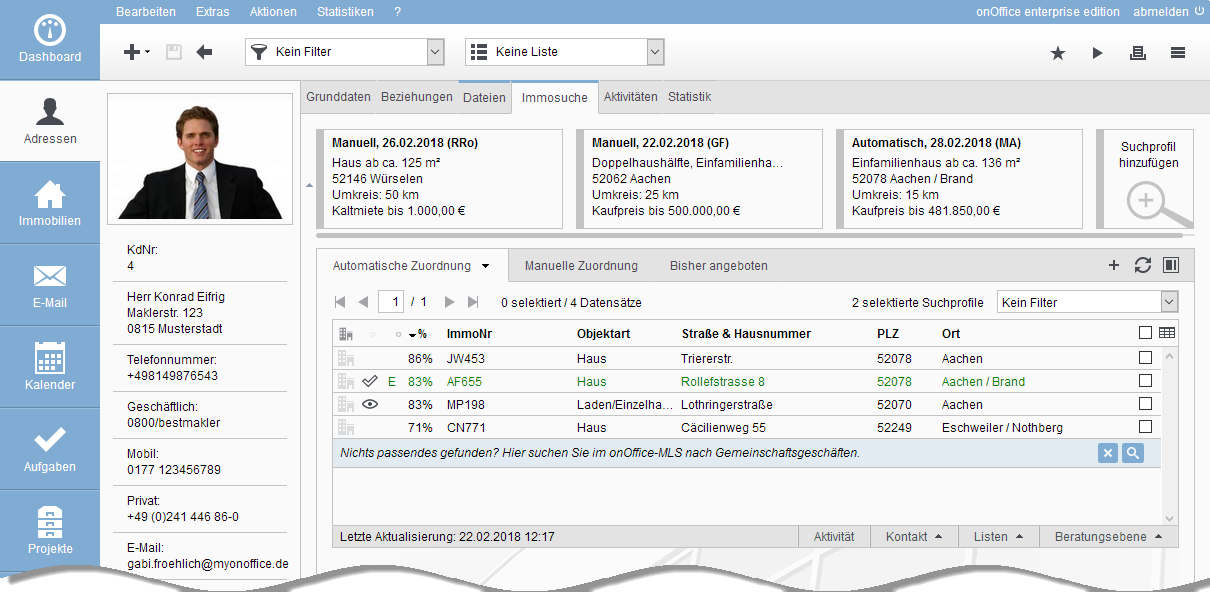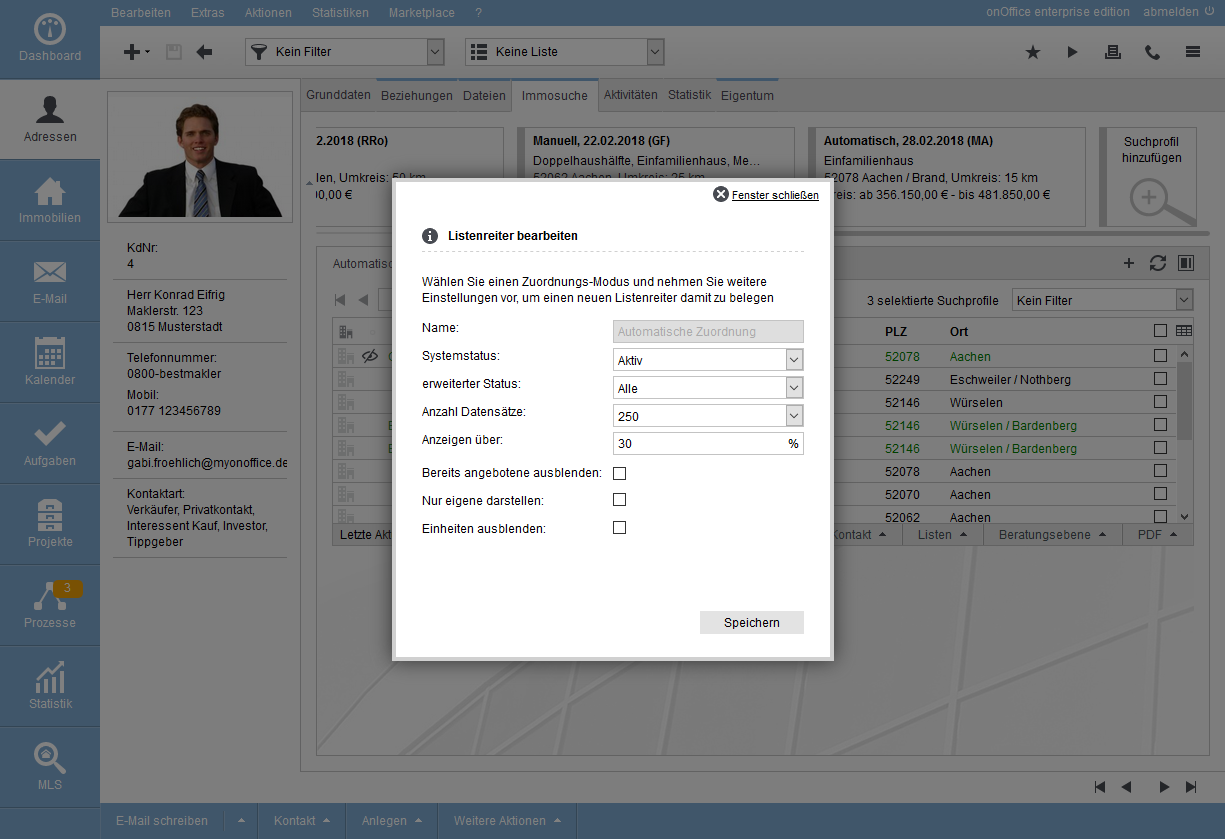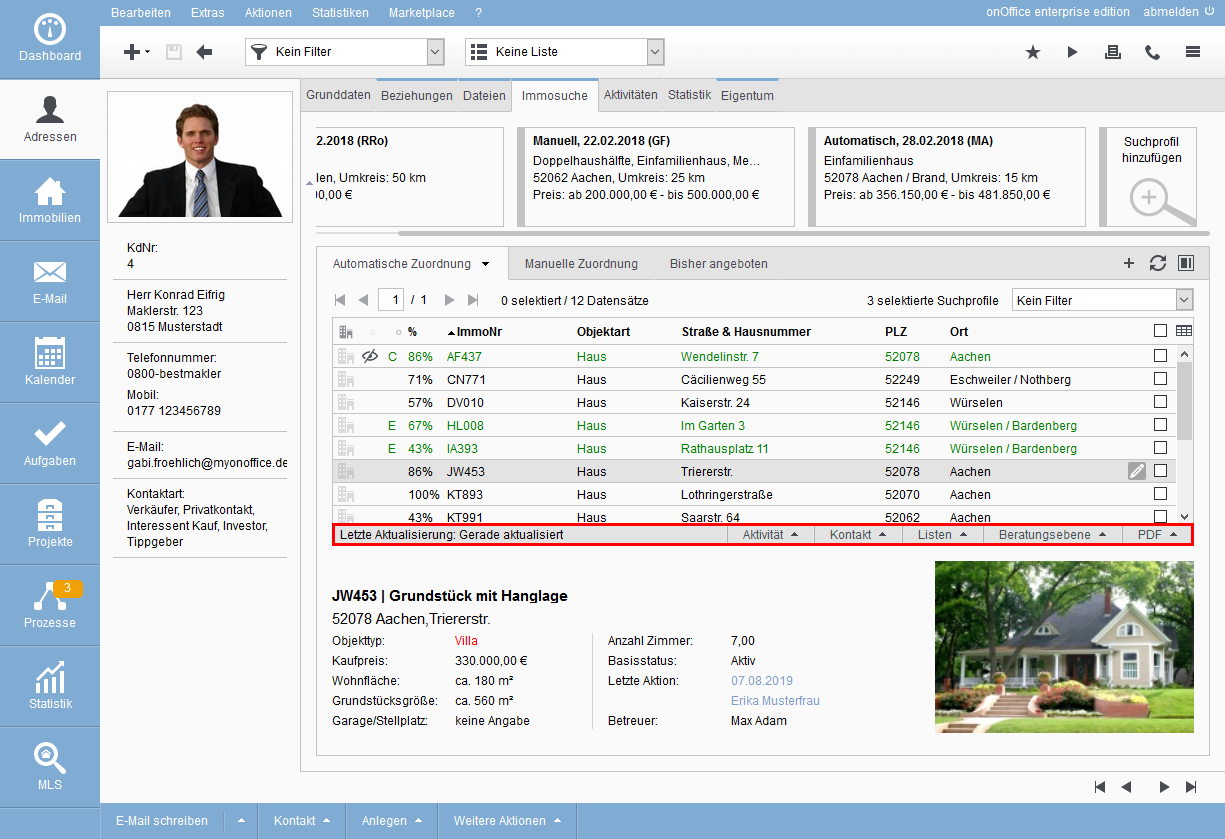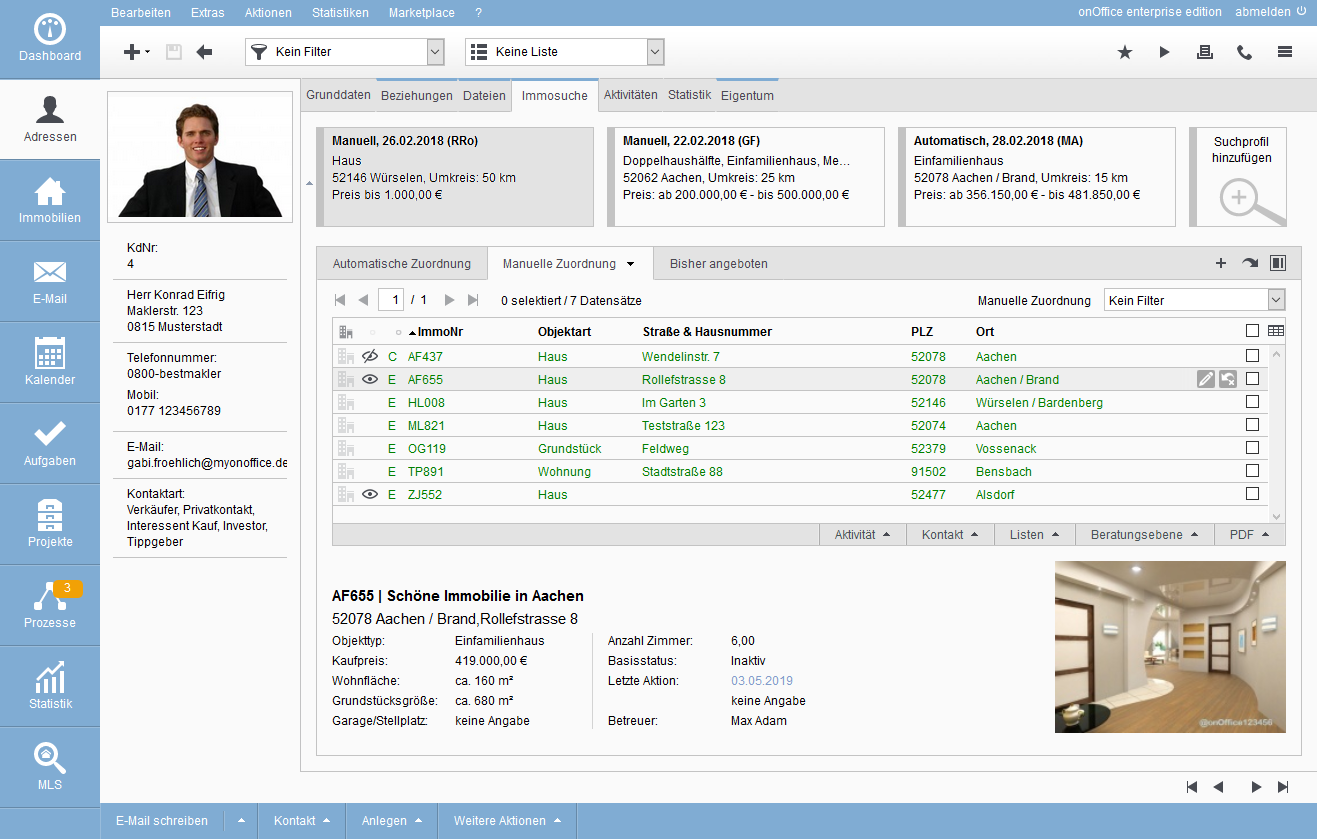You are here: Home / Modules / Contacts / Address detail view / Property search – overview / Property search - Details

Contacts
Property search – Details
Properties with the current address as owner and without the marketing status “open” are not displayed during automatic assignment.
Detailed information on search profiles, function, results and further steps can be found here, in addition to the Overview and Tutorial.
With the “property search” you can check properties and interested parties for “matching pairs”. This is based on the search profiles managed in the “Property search” tab. If a search profile exists, the tab at the top is highlighted in blue. A Training video is available.

The detailed information on the properties can be displayed at the bottom or on the right, or on the right-hand side for long lists. The search profile bar can be reduced.
Actions are possible with the results of the property search, e.g. direct dispatch of offers.
Search profiles
Search profiles Representation
The search profiles are displayed in groups in the search profile bar, first manually and then automatically created. The most recent/most recently edited is displayed first. Each profile has a tile with main properties. The magnifying glass preview ![]() shows further details when hovering over the tile.
shows further details when hovering over the tile.
By User rights can determine which search profiles the user can see or edit.
Search profiles can be active (green) or inactive (red) can be displayed. A status change can be made manually, via the Validity or by interested parties via e-mail macros (_AdrSearchCriteriaDeactivate(), _AdrSearchCriteriaUpToDate()) or the Address completion. Automatic inactivation via validity requires activation of the “Search criteria – automatic expiry” option in the “Automation” tab in the basic settings.
If there is a lack of space, the search criteria bar can be collapsed and then only shows the data of the most recent/pinned profile and the number of search criteria.
Create search profiles manually
New search profiles can be created via “Add search profile” in the bar on the right or via the action bar >> Search criterion from anywhere in the address data record. A lightbox for entering criteria opens. The criteria are listed in the “Search criteria” tab Field name and field value. The “KO criterion” column influences the search result, see below for further details.
The standard criteria can be set in the Administration can be customized. Search profile templates can also be created, used and exchanged there. When swapping search profile templates, the fields described remain active. Additional fields can be added via “Select new field” and “Create new field” – all active real estate fields – or removed via the trash can symbol.
In addition Administrative information such as creator, date, supervisor, status and validity. Characteristics such as automatically created or changed via address completion are also recorded.
The Commentstab is used for public (if “Tenant / buyer finder” is booked, possibly on the website) and internal comments on requirements/requests.
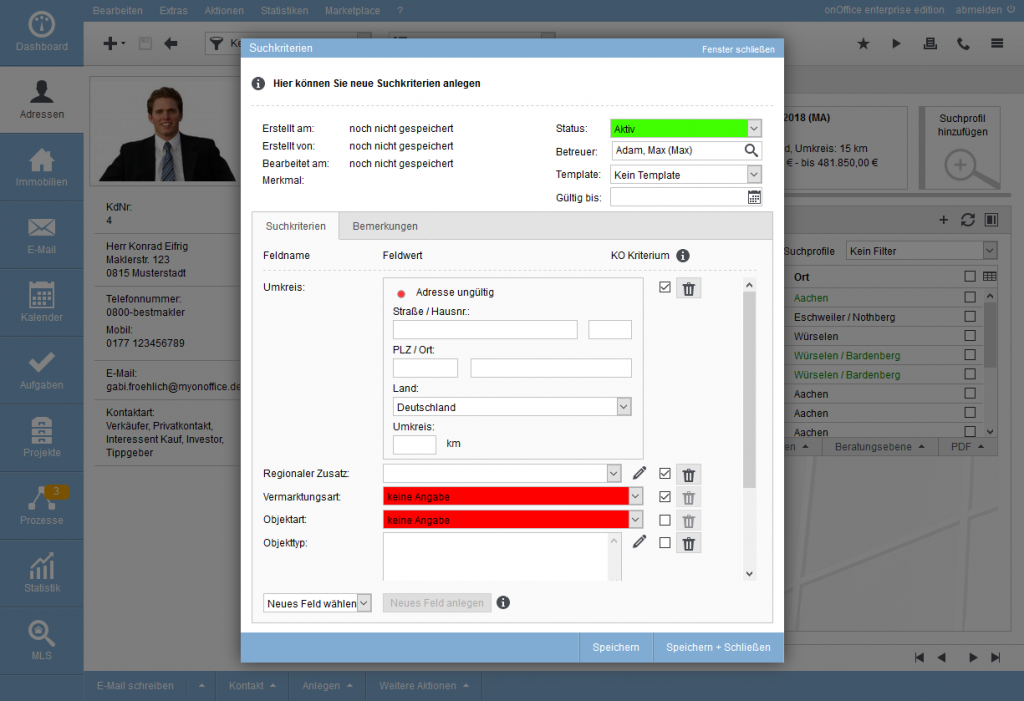
Example of individual fields in combination with KO criteria:
Interested party wants an apartment with pets allowed and bathtub. Create fields “Bathroom” and “Pets”, tick in column KO criterion column.
Important: By default, properties without the KO criteria information are still found. For a stricter search – only properties with stored and matching information – this can be set in the Basic settings under “Search for interested parties/properties”.
Some points on search criteria:
- Regional Addendum: Alternative geographical assignment to the radius search. Must be activated and configured must be activated.
- Required fields: Mandatory information is possible (highlighted in red) and can be entered in the Administration be configured.
- From-to information: Possible for numerical values (areas, number of rooms, purchase price). For example, take into account the information “divisible from” for commercial spaces.
Change search profiles
The search profile can be edited by clicking on the search criteria tile. The lightbox also has the “Delete” and “Duplicate” buttons in the Actions bar >> Further actions. Are you part of the onOfficeMLS the “MLS search” button also appears for a direct search in the MLS.
Delete search profiles
Search criteria can be deleted via the trash can symbol which is displayed when hovering over the search criteria tile. or in the lightbox via Action bar >> Further actions >> Delete.
Create and edit search profiles, further options
Search profiles can be created or edited in other ways. This is noted in a characteristic or as an internal comment in the search profile itself.
Search profiles can be entered by the interested parties themselves via the contact completion . If you have configured contact completion accordingly, editing is also possible.
Search profiles can also be created automatically when assigning a property to an contact activity. If this is activated in the basic settings , a “Checkbox – Generate search criteria automatically” is displayed in these cases, e.g. in an email, task, in a agent’s log entry or also in the property search in the tab “Manual assignment” .
Search profiles Settings
Search profiles can of course be adapted to your wishes. The lightbox criteria can be specified in Administration >> Search Criteria. Templates with specific criteria for e.g. residential and commercial properties can also be created there.
The search profile tile can also be configured in the administration . The list settings for the search profile tile can be found under Tools >> Settings >> Administration >> Lists >> Configure from: Lists ; Module: Property search ; List: Profile tile.
The automatic search criteria and the validity of the search profiles is configured via Basic Settings >> General >> Automatic Search Criteria.
Find targeted properties in MLS-onOffice with search profiles
As a participant in the onOffice MLS , you can search the MLS for properties matching the current search profile. To do this, click on the link at “External search:” in the magnifying glass popover at the bottom.
Use property search
The property search with results list and detailed view takes up the rest of the tab. Based on the search profiles, thepproperty search looks for properties matching the current contact data record . The result of the search is then displayed as a table list – by default in the “Automatic assignment” list tab. As usual, the list tabs and the table itself can be customized to your own preferences, just like in the Property module. The list rider configuration has been extended to include the settings for the property search. In addition to the settings in the list tab configuration, the result can be narrowed down using a property filter at the top right of the navigation area. This filter applies to all list tabs.
A practical example for a property search and an offer email can be found in the tutorials, here the configuration and the connections are explained in more detail.
Search versus display
Although it sounds trivial, an important point is the difference between display and search. The result of the property search is stored in the background and the properties to be displayed are listed according to the configuration of the list rider. If a match of at least 75% is set instead of a match of at least 90%, the list view of the properties will be rebuilt, but NOT the search result will be redetermined. The date and time of the last update are displayed at the bottom left of the list action bar. To refresh the search results, there is a Refresh button ![]() at the top right of the list. However, there is one fundamental exception to this: When the Property search tab is opened, the results list is updated once – i.e. every time the tab is changed.
at the top right of the list. However, there is one fundamental exception to this: When the Property search tab is opened, the results list is updated once – i.e. every time the tab is changed.
This automatic update can be changed in the user settings via the option “Automatically update search results when entering the property search”. Without this option, the results list for this contact record will remain in the background even if you change tabs or switch to another module.
To be more precise, the update is not carried out when the property search tab is opened, but when a list tab with the “automatic assignment” mode is opened for the property status set there for the first time – and therefore for all list tabs that have the same combination of mode and status. If there are 2 list tabs for automatic assignment with different status specifications, the update for this status is only triggered when this list tab is opened.
How do you search?
The property search compares all properties with the active search profiles stored in the current contact data record. For each pair of search profile and existing property, a match value is calculated and displayed as a percentage in the list. A match for all specified criteria then results in 100%, for each deviation the value is reduced. A conclusion from the percentage value to the deviating property is not possible, via the detailed view deviations are partly displayed. If a property costs more than required, this results in a lower value for the match.
criteria, which are set as KO criteria, do not result in a deviation. However, the property must meet these requirements in full, otherwise it will not be included in the list of results. Thus, if all criteria are KO criteria, only fully matching properties would be offered. Why isn’t that the default? Example: A prospective buyer is looking for a property with a purchase price of up to €350,000, an otherwise suitable property is on offer for €360,000. If the purchase price is a KO criterion, this property will not be found as a hit. However, it may well be that the difference of €10,000 is not an obstacle in the negotiation and the property can be brokered by you. Similarly for the type of property, etc.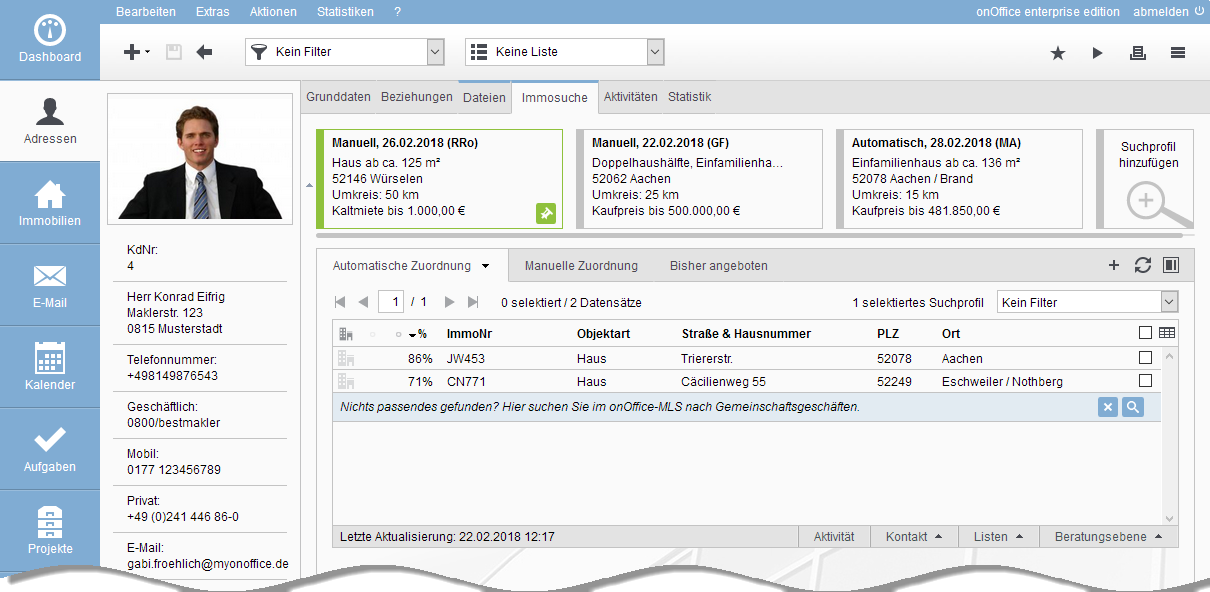
If several search profiles are stored in an contact, the property search is carried out for each profile. However, sometimes you want to limit the search to a specific search profile. For this purpose, a search profile can be pinned ![]() . The pinned search criterion is highlighted and selected for all result list tabs. Clicking on the pin symbol again
. The pinned search criterion is highlighted and selected for all result list tabs. Clicking on the pin symbol again ![]() or leaving the tab “Property search” releases the pin again.
or leaving the tab “Property search” releases the pin again.
Result list, what is output?
No matter whether all search profiles or a single one are used as a basis, the result of the property search is a list of more or less suitable properties. This list can be further filtered and narrowed down to find the best properties.
First, look at the number of properties displayed above the list of results, as well as in the list on the column with the match. For very extensive lists, this can be narrowed down further, e.g. by only displaying your own properties or by selecting a property filter.
If the result does not contain the right property, you can, for example, lower the minimum percentage value for the match or display properties other than your own.
Note: only properties that have the marketing status “open” will be displayed in case of automatic assignment.
Besides the sorting and the property filter, all other options are set via the list rider configuration. If you frequently use certain other filtering in addition to the standard criteria, you can create and configure corresponding list tabs for this purpose.
For example, the list tab “Automatic assignment” could only display your own properties with the status “active marketing” and a match of more than 80%. Another list tab could set the match to 60% or show not only “own” or also search the “currently incoming” properties
(status = preparation).
Some list entries are highlighted in color and some activities are displayed as icons in the list. The following table provides an overview.
Green – interested party already contacted
Red – interested party has canceled![]() – viewing appointment arranged
– viewing appointment arranged![]() – viewing appointment canceled
– viewing appointment canceled
Results list, what next?
For hits with less than 100%, you can take a closer look at the property to verify your properties. Click on the entry in the list, then the most important details such as type of property / kind of property, prices, areas/rooms, owner and supervisor etc. are displayed at the bottom/right. If the deviating criteria affect the displayed properties, these are shown in red in the details.
By clicking on an image, you can start a gallery of the property images, or double-click to open the property record and check the other properties.
Click on the hover icon “Enter purchase price offer” next to each list entry to open a lightbox in which you can manually enter a purchase price offer for the current address for this property. Older, possibly existing purchase price offers are overwritten. When a purchase price offer is changed, an activity is written to the address and property concerned. The purchase price offers can be configured as a separate column “Purchase price offer (interested party)” for the list on the tabs Property search for addresses and Interested parties for properties. In the property feedback via the “Activate purchase price offer” option, you can also directly request purchase price offers from your customers, e.g. after you have carried out a viewing.
You can use the list actions below the results list to carry out further actions with the result or a selection from it. Sie können z. B. eine E-Mail mit Exposés versenden, einen Termin erstellen, eine Aktivität (z. B. nicht erreicht bei einem Anruf) erstellen, Arbeitslisten erzeugen oder über den Eintrag “1-Klick Exposé” direkt ein Exposé versenden.
Im Vergleich zur Aktionenleiste im Adressdatensatz haben die Listenaktionen den Vorteil, dass die ausgewählten Immobilien bereits als Verknüpfung übernommen werden, z. B. in den E-Mail-Composer.
Use the list actions from “Contact” to define a relationship between a contact record and a property record. The status of this relationship is noted as“advisory level” and explained below.
As a participant in the onOffice MLS , you can also always search for properties by clicking on the magnifying glass icon ![]() in the note at the bottom of the list.
in the note at the bottom of the list.
Results list, other properties
As with all lists, only properties for which you have read permission are displayed. With the corresponding user right (“Display third-party properties”), other suitable properties are also displayed in encrypted form. Click “Request Access” to send the property manager an email with your contact information.
Manual Assignments” and “Previously Offered” list tabs
You know of a property for the interested party that was not displayed in the automatic property search and would like to list it here as a potential property? You can use the “Manual assignment” list tab to keep a corresponding list of assignments and include additional properties ![]() . Again, you can customize the view via property filters and list rider configuration as well as use list actions. All properties are displayed, regardless of their status.
. Again, you can customize the view via property filters and list rider configuration as well as use list actions. All properties are displayed, regardless of their status.
An offered property is of course noted as a corresponding activity in the current contact record and in the property agent’s log of the property, a quick clear list can be found here in the tab “property search” with the list tab “previously offered”. All properties are listed here, regardless of their status, for which an activity exists that is linked to the respective contact.
The columns “offered on” and “offered for” can be added via the list configuration. The date or price of the last offer is displayed there.
Advisory level
The consulting level describes in which stage of the sales process the prospect is. The consulting levels are defined from A (lease/purchase agreement signed) to G (cancellation).
You can set this consultation level manually, e.g. via the list actions in the Property search tab or in Activities.
However, it is also set automatically, e.g. in the following cases:
- Consultation Level E: When a letter/mail with contact or property reference is sent to the prospect or a file/brochure is sent from the property, if the consultation level was previously F or empty.
- Consultation Level C: If the prospective customer gives positive feedback during the property feedback.
- Consultation Level G: If the prospective customer gives negative feedback in the property feedback.
However, automatic actions can also depend on the consultation level: E.g. the automatic brochure dispatch for contact-property pairs checks whether an offer has already been created with one of the following consulting levels: A, B, C, D, E. If not, an offer will be sent automatically.
Below is a table showing the different levels of advice.
| Advisory level | Explanation | Font color |
| A | Rental/purchase agreement signed | Green |
| B | Written rental/purchase commitment | Green |
| C | in intensive conversation | Green |
| D | Interested, but still examining | Green |
| E | Receive documentation | Green |
| F | Documentation ordered | Green |
| G | Cancel | Red |

 Entry
Entry Dashboard
Dashboard Contacts
Contacts Properties
Properties Email
Email Calendar
Calendar Tasks
Tasks Acquisition Cockpit
Acquisition Cockpit Audit-proof mail archiving
Audit-proof mail archiving Automatic brochure dispatch
Automatic brochure dispatch Billing
Billing Groups
Groups Intranet
Intranet Marketing Box
Marketing Box Multi Property module
Multi Property module Multilingual Module
Multilingual Module onOffice sync
onOffice sync Presentation PDFs
Presentation PDFs Process manager
Process manager Project Management
Project Management Property value analyses
Property value analyses Enquiry Manager
Enquiry Manager Showcase TV
Showcase TV Smart site 2.0
Smart site 2.0 Statistic Tab
Statistic Tab Statistics toolbox
Statistics toolbox Success Cockpit
Success Cockpit Time Tracking
Time Tracking Address from clipboard
Address from clipboard Text block
Text block Customer communication
Customer communication External Tools
External Tools Favorite links
Favorite links Calculating with formulas
Calculating with formulas Mass update
Mass update onOffice-MLS
onOffice-MLS Portals
Portals Property import
Property import Quick Access
Quick Access Settings
Settings Templates
Templates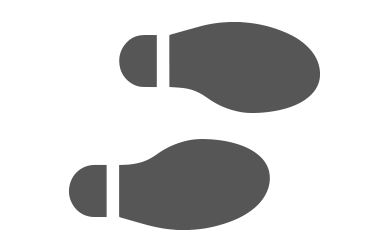 Step by step
Step by step